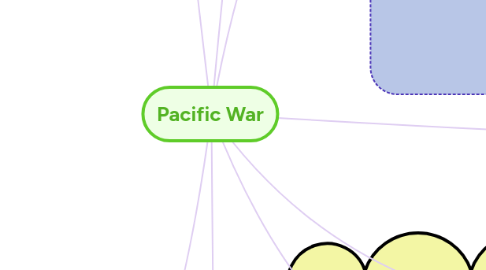
1. BEGINNINGS OF WARFARE
1.1. VS. China
1.1.1. Already held Manchuria
1.1.1.1. "still wanted more"
1.1.2. Soviet/Japan neutrality pact in place
1.2. VS. West/Allies
1.2.1. Cooperation through trade ceased
1.2.2. Japan entered Dutch East Indies 17th Dec, 1941 after Netherlands declared War on 8th
1.2.3. "Southern Plan"
1.2.3.1. Take Hong Kong/Malaya
1.2.3.2. Follow through Malaya to Australia
1.2.4. "Eastern Plan"
1.2.4.1. Eliminate Pearl Harbour
1.2.4.2. Take Guam to shut US Communications
1.2.4.3. Invade Phillipenes and Singapore
1.2.5. ABCD Line
1.2.5.1. Line of oil embargos placed on Japan
1.2.5.2. "American-British-Chinese-Dutch Encirclement"
1.2.6. Economic collapse of Japan inevitable without the war for resources.
1.2.7. Emperor Hirohito mistakenly believed that they'd be able to negotiate for peace after territorial gains.
2. COURSE OF WAR
2.1. ALLIES REGROUP
2.1.1. Battle of Coral Sea
2.1.1.1. May 1942
2.1.1.1.1. First of 6 aircraft carrier fights
2.1.2. Battle of Midway
2.1.2.1. June 1942
2.1.2.1.1. Japanese attempt to destroy US carriers after Coral Sea failures
2.1.2.1.2. Four Japanese carriers lost
2.1.2.1.3. Strategic/Defensive victory for US
2.1.2.1.4. Only one American carrier destroyed
2.1.2.1.5. Four Japanese carriers lost
2.1.3. Americans land
2.1.3.1. November 1942
2.1.3.1.1. Guadalcanal Campaign
2.1.4. British fight back
2.1.4.1. January 1943
2.1.4.1.1. Battle of Buna-Gona (New Guinea)
2.1.5. Defeat in sight
2.1.5.1. July 1943
2.1.5.1.1. Americans take New Guinea
2.1.5.2. November 1943
2.1.5.2.1. Americans land on Tarawa
2.2. FINAL STRUGGLE
2.2.1. Battle of the Phillippine Sea - 1944
2.2.1.1. Great Marianas Turkey Shoot -
2.2.1.2. Eliminated all of Japanese Navy's large scale carriers.
2.2.1.3. Did take back the Philippines by '45
2.2.2. Battle of Okinawa
2.2.2.1. Bloodiest battles of the War
2.2.2.2. 115,000 Japanese killed (kamakazi beliefs took control)
2.2.2.3. 1/4 of civilian population killed
2.2.3. Atomic Bomb
2.2.3.1. Hiroshima "Little Boy"
2.2.3.1.1. Dropped 8th August, 1945 by Enola Gay
2.2.3.1.2. Immediately killed 80,000
2.2.3.1.3. By years end casualties rose to 140,000
2.2.3.2. Nagasaki "Fat Man"
2.2.3.2.1. Dropped 10th August, 1945 by Bockscar
2.2.3.2.2. 60,000 casualites
2.2.3.3. Hirohito surrendered officially on 15th August, 1945
2.3. JAPAN PROSPERS
2.3.1. Japan captures:
2.3.1.1. Hong Kong - 1941
2.3.1.2. Singapore - February 1942
2.3.1.2.1. 130,000 captured in Battle of Singapore
2.3.1.2.2. Major British defeat
2.3.1.3. Bataan - April 1942
2.3.1.3.1. Major American defeat
2.3.1.4. Burma - May 1942
2.3.1.4.1. Major British defeat
2.3.2. Attacks on OZ- Feb1942
2.3.2.1. First air raids - February 19
2.3.2.1.1. Two companies meant for Burma diverted back to Darwin to regroup
2.3.2.1.2. OZ asked US for aid against Japanese
2.3.2.1.3. Roosevelt then placed Australia under McArthurs command
2.3.3. An Investigation of Global Policy with the Yamato Race as Nucleus- July 1942
2.3.3.1. Belief that Yamato Race was core to superiority of Asia
2.3.3.1.1. Thought of Koreans as lower-classed Asians whom could be assimilated.
2.3.3.1.2. Did, however, push the importance of a Pan-asian identity, even if Japan was number one
2.3.3.1.3. Released by Ministry of Health and Welfare
3. United Nations created instead of LoN.
4. Invaded Thailand Dec 8, 1941 HOWEVER, Phi Bun politician was making pacts with Japan w/o rest of Thailand's consent.
4.1. Surrended in 7 hours
4.2. Lack of French Defense would lead to First Indochinese War in 1946 that got rid of colonialists. British pushed back to India.
5. SHORT TERM CAUSES
5.1. Japan's Economic Needs
5.1.1. Isolated until 1850's
5.1.2. Fast to Industrialize
5.1.3. Militaristic/Kamakazi Society
5.1.4. Took Taiwan (1895) and Manchuria (1931) quickly
5.1.5. ISLAND NATION: Lots of people; limited resources
5.1.6. BUT
5.1.7. League of Nations failed to aid Manchuria
5.1.7.1. Japan did leave 1933
5.1.8. Lytton Committee failed to implement sanctions
5.2. Changes to leadership
5.2.1. Prime ministed assassinated
5.2.2. Power given to Admiral Saito Makoto
5.2.3. War started with China again in 1937
5.2.4. Signed Tripartite Pact with Germany/Italy in 1939
5.3. Tensions vs. U.S.
5.3.1. US pushed for oil/steel embargo + UK/Netherlands
5.3.2. Roosevelt declined to meet Makoto until he left Manchuria
5.3.3. Japan saw Dutch East Indies as solution to Oil deficit in their nation.
6. EFFECTS OF WAR
6.1. POST-WAR CONFLICT
6.1.1. Civil War in Greece
6.1.2. Beginnings of Cold War
6.1.3. Korean War
6.1.4. Malaya enters state of emergency
6.1.5. French Indochina War
6.1.6. China leaves as Communist reigme
6.2. REBUILDING
6.2.1. US gives aid through Marshall Plan
6.2.1.1. But Soviets deny
6.2.1.2. And so do the satellite nations
6.2.2. Warsaw Pact initiated by Soviets
6.2.3. US aid creation of Japanese Constitution.
6.2.4. Soviets lose 40 million people
6.2.4.1. War
6.2.4.2. Famine
6.2.4.3. Disease
6.2.5. Hiroshima/Nagasaki destroyed
6.2.5.1. Many other cities firebombed
6.3. REPARATIONS
6.3.1. Nations ordered to pay for damages
6.3.2. GERMANY
6.3.2.1. Free coal deliveries to France
6.3.2.2. "Intellectual reparations" to US
6.3.2.2.1. Movement of patents to US
6.3.2.2.2. Shift of intellectuals/scientists to US
6.3.3. Hungary/Finland/Romania paid for USSR
6.3.3.1. HEGEMONY
6.4. WAR CRIMES
6.4.1. Nuremburg Trials
6.4.2. Hitler / Himmler / Goering commit suicide
6.4.3. Hirohito escapes punishment through cultural ties to suicide and fighting to death.
6.5. CHANGES TO GLOBAL POWER
6.5.1. British Empire collapses
6.5.1.1. UK exhausted (55% labour in war materials)
6.5.1.2. India Independence claimed
6.5.1.3. Lost standing after almost defeated in two WWs
6.5.2. Two new superpowers emerge
6.5.2.1. Start of Cold War
6.5.2.2. Beginnings of hegemonic rule
6.5.2.3. Shifts in Ideologies evident

